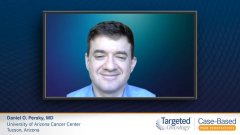
Future Therapeutic Options for Diffuse Large B-Cell Lymphoma
Considering a patient’s relapse and potential response to therapy, Daniel O. Persky, MD, looks forward to the future use of novel therapies in diffuse large B-cell lymphoma.
Daniel O. Persky, MD: Going back to the case of our 73-year-old patient who relapsed after 6 cycles of R-CHOP [rituximab, cyclophosphamide, doxorubicin, vincristine, prednisone], and then received polatuzumab with bendamustine and rituximab, we could very well expect that patient to have a response, perhaps even a complete response to this regimen. Then unfortunately, we would probably expect this patient to have a relapse again, and then at that point [we] would need to consider further treatment options. Fortunately, we have a lot more to offer this patient than we had even 2 years ago.
It is important to note that there’s been a lot of progress made in treating relapsed/refractory [R/R] diffuse large B-cell lymphoma [DLBCL] in the last literally 4 years. We’ve had 4 different treatment regimens approved in the setting, and that’s not counting 3 CAR [chimeric antigen receptor] T-cell products that are approved, which some patients who perhaps are not completely fit for autologous stem cell transplant could receive. Although, that is a minority of patients. Other therapies that are approved in this setting include some of the therapies that I’ve mentioned, such as tafasitamab and lenalidomide, selinexor, and the most recent one has been loncastuximab tesirine. And of course, many more regimens have been studied in the setting. Previously, there have been regimens that relied on the use of BTK [Bruton tyrosine kinase] inhibitors, like ibrutinib, and the use of cerebral modulating agents like lenalidomide, especially for non-GCB [nongerminal center B-cell] DLBCL.
For example, [a] regimen sometimes called IR2, which is ibrutinib, lenalidomide, and rituximab, had publication…in Blood in 2018. However, the landscape of R/R DLBCL continues to evolve very rapidly. We are expecting approval of [the] first bispecific antibody in follicular lymphoma. [The] bispecific antibodies that we’re discussing here are directed against both CD3 and CD20, linking the effector T cells in a more direct way to kill the lymphoma cells expressing CD20. There are some good data there for DLBCL, so there is an expectation of continued rapid development in this area. However, there are still significant unmet needs, because patients, particularly with nontransplant-eligible relapsed DLBCL, obviously aren’t cured at this point in time.
We are hopeful that some of those patients who are potentially eligible for CAR T cells may have obtained long-lasting remissions and potentially could be cured, but we need a longer follow-up to determine that. Not having a curative scenario in this setting means that we often have to cycle therapies, or at least string along several therapies, to preserve our patients’ quality of life and have them live as long as possible with great quality of life. This becomes increasingly harder as patients are subjected to more and more lines of therapy and can acquire nonreversible toxicities of therapies. We have to be careful in making sure that our patients receive treatment that doesn’t compromise them long term and that we look at least 1 step ahead in terms of what’s available for our patients when we decide on our therapies.
I think that double- and triple-hit lymphomas remain a major unmet need, both in first-line therapy and relapse, so there’s a lot of work being done for them as well. I think that the era of molecular medicine in DLBCL has not started yet but is likely to start in the next, I would say, 2 to 3 years as we get more consensus on molecular subtypes of DLBCL. As we know, there are several that will lead to further subclassification of DLBCL beyond the cell of origin and beyond the double- and triple-hit lymphoma. Once there is some consensus around those molecular subtypes, there’s likely going to be a concerted effort to develop a treatment for each individual subtype that is considered unfavorable.
This transcript has been edited for clarity.








































